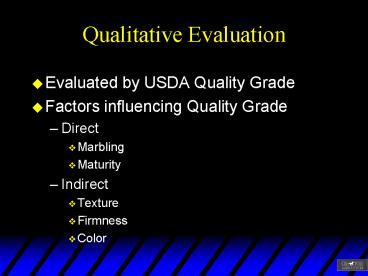Qualitative Evaluation
1 / 34
Title:
Qualitative Evaluation
Description:
Heifer. Steer. Bull. Sex Effects. At comparable weights & frame sizes. Heifers will have slightly more marbling. Bulls will have slightly less marbling. Maturity ... –
Number of Views:61
Avg rating:3.0/5.0
Title: Qualitative Evaluation
1
Qualitative Evaluation
- Evaluated by USDA Quality Grade
- Factors influencing Quality Grade
- Direct
- Marbling
- Maturity
- Indirect
- Texture
- Firmness
- Color
2
Why is marbling so Important?
- Prime 1 in 26
- Upper 2/3 of Choice 1 in 19
- Lower 1/3 of Choice 1 in 7
- Select 1 in 5
- Standard 1 in 2
- Quality Grade Odds
- Odds of getting a steak that is slightly
undesirable or worse in overall palatability
3
Marbling
- Abundant
- Moderately Abundant
- Slightly Abundant
- Moderate
- Modest
- Small
- Slight
- Traces
- Practically devoid
- Devoid
Greatest
Leanest
4
Modest Choiceo
Moderately Abundant Primeo
5
Modest Choiceo
Slightly Abundant Prime-
6
Moderate Choice
Modest Choiceo
7
Modest Choiceo
Small Choice-
8
Modest Choiceo
Slight Select
9
Moderately Abundant Primeo
Slightly Abundant Prime-
Moderate Choice
Modest Choiceo
Small Choice-
Slight Select
10
(No Transcript)
11
Sex Effects
- At comparable weights frame sizes
- Heifers will have slightly more marbling
- Bulls will have slightly less marbling
12
Maturity
- Included because age influences eating quality
- Tenderness
- Juiciness
- Flavor
- Physiological age, not chronological age
- Represents point on growth curve animal has
reached at slaughter
13
- Determined by ossification of bones/joints
- Vertebrae
- Sacral
- Lumbar
- Thoracic
- Ribs
- Color/texture of ribeye muscle
14
Maturity Grade Changes
- The older the animal, the more variability in the
eating characteristics - Since January, 1997
- Select grade only applies to A maturity cattle
- Marbling required for Choice grade was increased
- Affects
- Older feeder cattle, e.g. Mexican steers
- Heiferettes - 2-yr old females that did not get
pregnant, and were sold as fed cattle
15
3 Minor factors Affecting Quality Grades
- Muscle texture
- Muscle color
- Firmness
16
(No Transcript)
17
Quantitative Evaluation
- Evaluated by USDA Yield Grade (1965)
- Estimate of the edible portion of the four primal
cuts
Thinnest, Leanest Wastiest, Fattest
1 2 3 4 5
High Low
Yield Grade
Cutability
18
High
Negative Correlation
Cutability
Low
1
2
3
4
5
Yield Grade
19
(No Transcript)
20
Factors Affecting Yield Grade
- Fat thickness over 12th Rib
- Percent internal (KPH) fat
- Carcass Weight
- Ribeye Area (REA)
21
Yield Grade Calculations
- Regression Equation
YG 2.50 2.5 x (inches backfat) 0.20 x
(KPH) 0.0038 x (lb Hot Carcass Weight) -
0.32 x (REA in2)
22
Yield Grade Calculations
- Using Correction Factors to adjust preliminary
yield grade - Preliminary yield grade is based on backfat
Backfat (inches) PYG 0.2 2.5 0.4 3.0 0.6 3.5
0.8 4.0 1.0 4.5
23
Backfat
- Depth of fat over the ribeye muscle at the 12th
rib. Single measurement 3/4 of the lateral
length of the ribeye muscle. - Every 0.2 inches of backfat is worth 0.5 yield
grade units
24
(No Transcript)
25
Carcass Weight Adjustment
- Base - 600 lbs
- Rule
- If HCW gt base, add to PYG
- If HCW lt base, subtract from PYG
- Amount to add/subtract
- 0.4 YG units per 100 pounds deviation, or
- 0.1 YG units per 25 pounds deviation
- Example
- 700 lb carcass, add 0.4 YG units to PYG
- 550 lb carcass, subtract 0.2 YG units from PYG
26
Ribeye Area
- Definition - Area of the longissimus muscle
measured at in squared inches at the 12th rib
interface on the beef forequarter. - Normal range - 10.0 to 18.0 in2
- Bulls will average about 1 in2 larger than
steers, and heifers will average about 1 in2 less
than steers of same weight.
27
Ribeye Area Measurement
- Use grid, count the dots
- Make outline with acetate paper, and use outline
for estimation
28
REA Adjustment
- Base - 11 in2
- Rule
- If REA gt base, subtract from PYG
- If REA lt base, add to PYG
- Amount to add/subtract
- 0.3 YG units per 1 in2 deviation
- Example
- 12 in2 REA, subtract 0.3 YG units from PYG
- 9 in2 REA, add 0.6 YG units to PYG
29
Internal Fat
- Kidney, Pelvic and Heart fat
- Definition - The internal carcass fat associated
with the kidney, pelvic cavity, and heart
expressed as a percentage of chilled carcass
weight - As KPH increases, cutability decreases.
Therefore, yield grade increases in numerical
value.
30
5 KPH
2.5 KPH
31
How to Predict KPH in Live Animal
Positive Correlation
32
KPH
- Normal range 1-4.5
- Dairy cattle will average about 1.5 more than
beef cattle of the same weight
33
KPH Adjustment
- Base - 3.5
- Rule
- If KPH gt base, add to PYG
- If KPH lt base, subtract from PYG
- Amount to add/subtract
- 0.2 YG units per 1 deviation, or
- 0.1 YG units per .5 deviation
- Example
- 4 KPH, add 0.1 YG units to PYG
- 2.5 KPH, subtract 0.2 YG units from PYG
34
Example Animal
- 700 lb carcass
- 0.6 inches backfat
- 3 KPH
- 13 in2 REA
- PYG 3.5
- Carcass weight adjustment 0.4
- REA adjustment -.6
- KPH adjustment -.1
- Final yield grade 3.2































